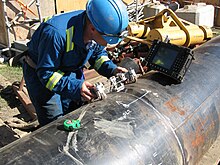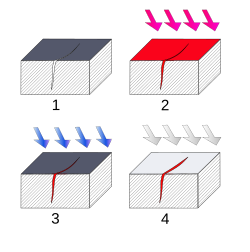Non-Destructive Testing (NDT) And Its Top 5 Methods

The following terms; NDT, NDE, and NDI have been used together in regard to; NON_DESTRUCTIVE TEST, NON-DESTRUCTIVE EXAMINATION or EVALUATION, and NON-DESTRUCTIVE INSPECTION respectively, these analysis techniques are used in science and technology industry to evaluate the properties of a material, component or system without causing damage to the material.
These techniques are not only necessary for economic reasons but also work to increase the reliability of already existing products or materials.
Due to the numerous benefit, they offer many industries are now buying into the idea of using NDT for all the material and product tests.
The current analyses have shown that the use of NDT in industries around the globe is increasing annually while some try to device means that are different from the already existing six methods of NDT.
The techniques beat other methods in the sense that it offers less time, low cost of inspection, higher reliability in result, and still keep the material useable, therefore they are usually employed in product evaluation, troubleshooting, and research.
There are six popular methods of NDT usually employed in industries, they are:
VISUAL INSPECTION (VI)
As the name implies, it is a common name for quality control and analysis collection which is obtainable through a thorough visual test.
In other words; it is a kind of inspection which is usually carried out through direct inspection using any physical material available such as; naked eyes, sunglasses, magnifying glasses, and hand held microscopes.
This test can be performed in any type of material but it is limited to surface defects only. So any defect in the interior of the material cannot be seen using this method.

ULTRASONIC TESTING (UT)
This is one of the popular NDT methods, it uses the propagation of ultrasonic waves in the object or material being tested.
In this method, very short ultrasonic pulse waves with center frequencies ranging from 0.1-15MHz and occasionally up to 50MHz will be transmitted into the material to detect internal flaws or to characterize the materials.
Ultrasonic thickness measurement is a good example of this type of test.

RADIOGRAPHY OR RADIOGRAPHIC TEST (RT)
This is a special type of NDT that utilizes the use of X-rays or gamma rays to examine and verify the inter structure and integrity of any material.
The method works by first taking an x-ray or gamma ray photograph of the material and have their films developed like that of an analog camera, the films developed are therefore subjected to radiographic film interpretation which can be carried by a certified NDT inspector.
This method ca be accurate and more reliable if properly carried out. The reason is that it can reveal both surface and internal flaws of the material.

DYE PENETRANT INSPECTION OR LIQUID PENETRANT INSPECTION (DPI or LPI)
It is a low-cost NDT method used for surface breaking defects in all non-porous materials such as; metals, plastics, ceramics, fibers, etc.
The material to be inspected will have its surface properly cleaned and dried.
The colored liquid will be spread on the material thoroughly and allowed to settle for about 20 minutes before spraying the next liquid whose color will contradict the first color, like having red and white liquids.
The second liquid sprayed will cause the excess liquids in the porous or defective surface to appear over the second liquid thereby revealing the defect in the area.

MAGNETIC PARTICLE INSPECTION (MPI)
This method can be employed in ferromagnetic materials only, such materials include, iron, steel, nickel, & cobalt, etc. It is a process of detecting surface and shallow subsurface discontinuities in ferromagnetic materials.
The process involves a magnetization action, in which a powdered iron filing or magnetic metal is sprinkled across the surface to be tested, while a two-leg electromagnetic induction material known as the yoke is made to induce electromagnetism across the area the iron filing is sprinkled.
When done in perfect procedure the iron filings will gather themselves in any area within the surface where there is a porosity, cracks, internal hole, etc. the reason for the reaction can be attributed to the new magnetic poles formed on the material through the yoke.
EDDY-CURRENT METHOD (ECT)
This is a method used in the NDT to test conductive materials. This method can only work if the material to be tested can conduct electricity, the reason is that it works on the principle of electromagnetic induction to detect and characterize surface errors. It is among the many electromagnetic testing methods used in NDT.
Summary
Notwithstanding the wide methods of the NDT, many fields of engineering have adopted the ones that best suit the area of their practice.
For instance, NDT has been adopted in the following field of engineering; forensic engineering, mechanical engineering, petroleum engineering, electrical engineering, civil engineering, aeronautical engineering, systems engineering, etc.
The recent interest by major nations across the globe to certify NDT inspectors according to lay down standards has shown that it will soon displace other types of testing in industries. These bodies include:
American Society for non-destructive testing (ASNDT), the NDT management association, the international committee for NDT, European Federation for non-destructive testing (EFNDT), and the British Institute of Non-Destructive Testing (BINDT), etc.
NDT can be employed in the following category of jobs in the industry; welded joints, rust machines, defective tools, defective machines, and preventive maintenance of all the materials in the industry.
